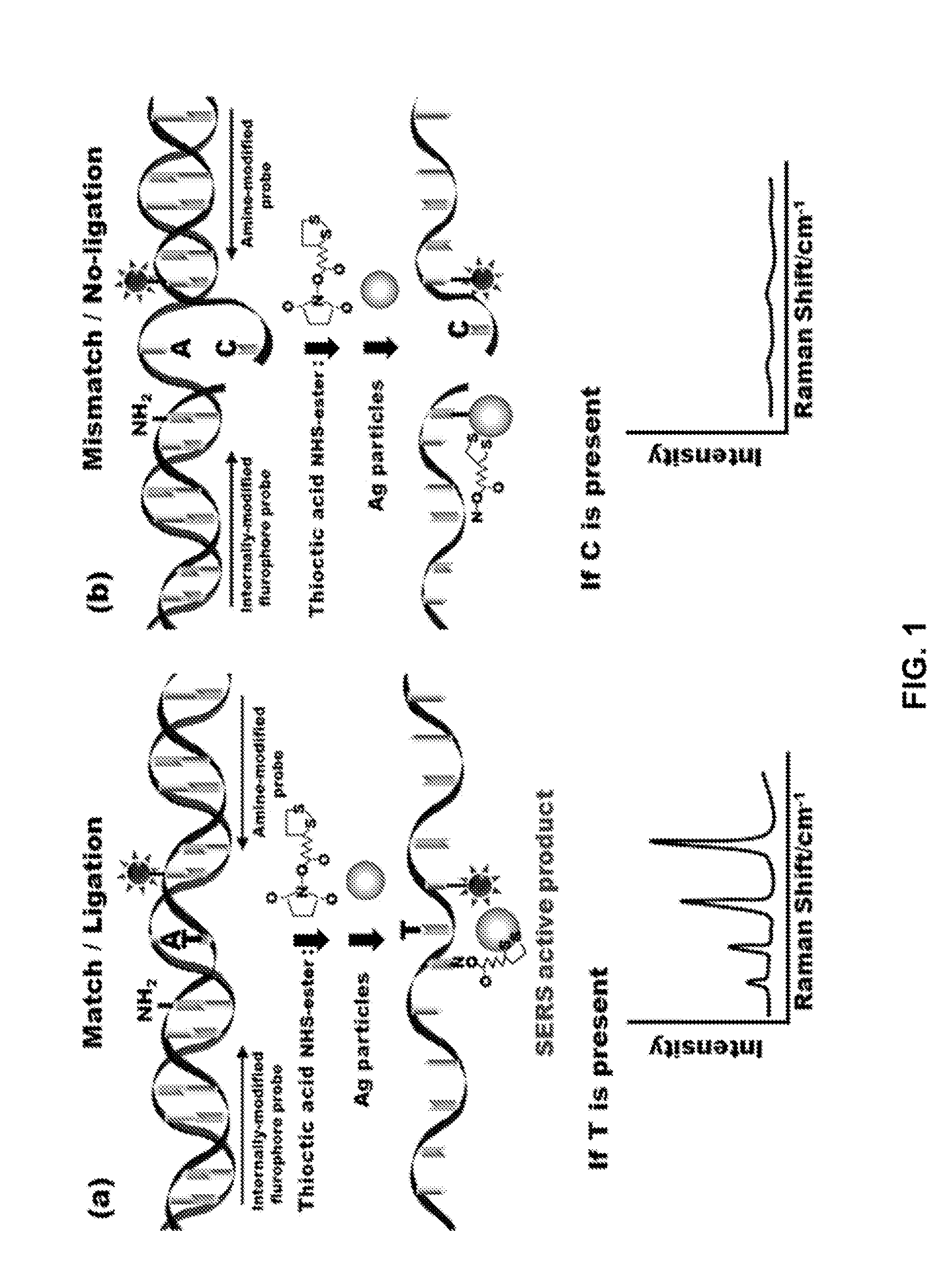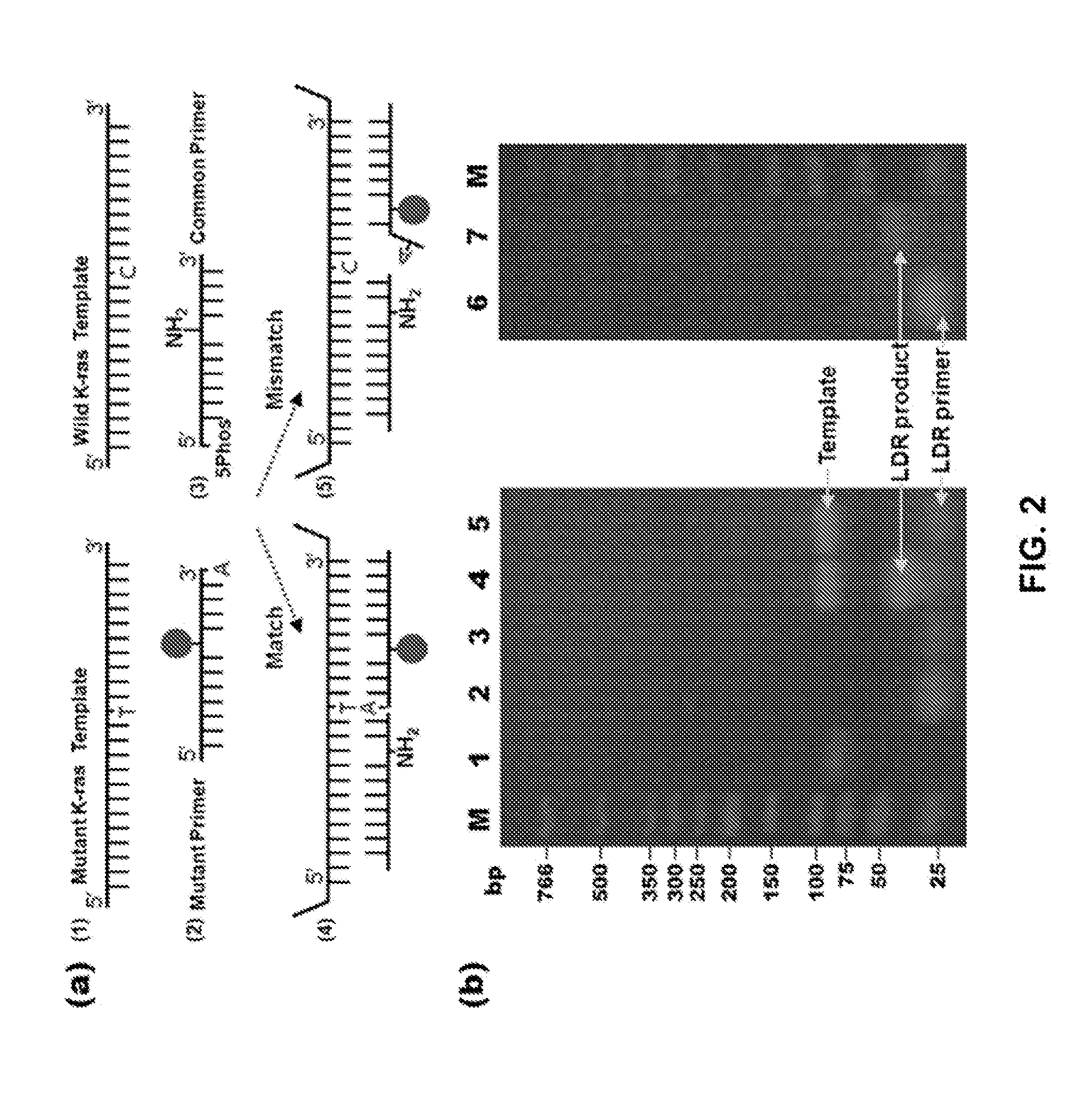Enhanced on-chip sers based biomolecular detection using electrokinetically active microwells
a biomolecular detection and electrokinetic technology, applied in the field of enhanced on-chip sers based biomolecular detection using electrokinetic active microwells, can solve the problems of difficult to obtain regular and repeatable sers enhancement, low detection sensitivity, and complex chip fabrication, etc., and achieve the effect of increasing the number of reactions among analytes in a given amount of tim
- Summary
- Abstract
- Description
- Claims
- Application Information
AI Technical Summary
Benefits of technology
Problems solved by technology
Method used
Image
Examples
example 1
6.1 Example 1
A Surface Enhanced Raman Scattering-Based Ligase Detection Reaction
[0162]6.1.1 Overview
[0163]Genomics provides a comprehensive view of the complete genetic makeup of an organism. Individual sequence variations, as manifested by single nucleotide polymorphisms (SNPs), can provide insight into the basis for a large number of phenotypes and diseases including cancer. The ability rapidly screen for SNPs will have a profound impact on a number of applications, most notably personalized medicine. This example demonstrates a new approach to SNP detection through the application of Surface Enhanced Raman Scattering (SEAS) to the Ligase Detection Reaction (U)R). The reaction uses two LDR primers, one of which comprises a Raman enhancer and the other of which comprises a reporter. In LDR, one of the primers is designed to interrogate the SNP. When the SNP being interrogated matches the discriminating primer sequence, the primers are ligated and the enhancer and reporter are broug...
example 2
6.2 Example 2
Enhanced On-Chip SERS Based Biomolecular Detection Using Electrokinetically Active Microwells
[0204]6.2.1 Introduction
[0205]This example demonstrates an embodiment of the LDR-SERS method using a microfluidic SERS detection device (“chip”) with electrokinetically active microwells.
[0206]The embodiment of the microfluidic SERS detection device comprises a plurality of microfluidic channels containing embedded microwells that, when electrically actuated, either locally attract or repulse species from solution through a combination of electrokinetic effects. This approach combines the advantages of existing homogeneous (solution phase) and heterogeneous (surface phase) on-chip techniques by enabling active mixing to enhance the at of binding, between the SERS enhancers and the biomolecular targets as well as rapid concentration of the product for surface phase optical interrogation.
[0207]This example describes the chip design and fabrication procedure, experimental results i...
example 3
6.3 Example 3
Multiplex SNP Genotyping Utilizing Ligase Detection Reaction Coupled SERS
[0241]6.3.1 Overview
[0242]Single nucleotide polymorphisms SNPs) have become key diagnostic markers for genetic disease, cancer progression, and pharmacogenomics. To identity SNPs, the ligase detection reaction (LDR) is one of leading methods, combining single molecule detection limits and high specificity. This example demonstrates multiplex LDR-Surface Enhanced Raman Spectroscopy (SERS) SN genotyping scheme. The diagnostic peaks of Raman are more distinct than fluorescence and, in theory, a large number of markers with different SHS spectra cart be multiplexed in a single sample. The example demonstrates LDR-SERS multiplex SNP genotyping of K-ras oncogene alleles at 20 pM detection levels, optimization of DNA labeling as well as Raman conditions, and the linear correlation of diagnostic peak intensity to SNP concentration in mixed genotype samples. Additionally, while synthetic template DNA was pr...
PUM
| Property | Measurement | Unit |
|---|---|---|
| height | aaaaa | aaaaa |
| diameters | aaaaa | aaaaa |
| thickness | aaaaa | aaaaa |
Abstract
Description
Claims
Application Information
 Login to View More
Login to View More - R&D
- Intellectual Property
- Life Sciences
- Materials
- Tech Scout
- Unparalleled Data Quality
- Higher Quality Content
- 60% Fewer Hallucinations
Browse by: Latest US Patents, China's latest patents, Technical Efficacy Thesaurus, Application Domain, Technology Topic, Popular Technical Reports.
© 2025 PatSnap. All rights reserved.Legal|Privacy policy|Modern Slavery Act Transparency Statement|Sitemap|About US| Contact US: help@patsnap.com



